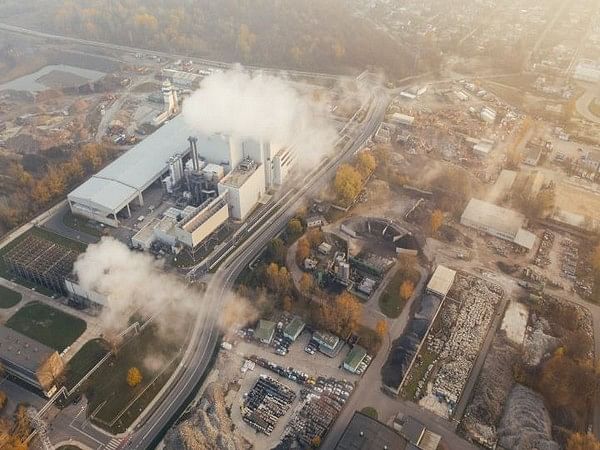Tokyo [Japan], June 4 (ANI): A novel carbon-capturing system has been developed by Tokyo Metropolitan University researchers that can extract carbon dioxide straight from the environment with unparalleled efficiency.
Isophorone diamine (IPDA) was reported to remove carbon dioxide at low concentrations in the environment with 99 per cent efficiency in a “liquid-solid phase separation” system. The compound is reusable, requires little heating, and is at least twice as quick as previous devices, making it an exciting new development for direct air collection. The research has been published in the journal, ‘ACS Environmental Au’.
The devastating effects of climate change are being felt around the world, with an urgent need for new policies, lifestyles and technologies that will lead to reduced carbon emissions. However, many scientists are looking further ahead than a net-zero emission goal, to a future “beyond zero” where we can actively reduce the amount of carbon dioxide in the atmosphere. In the field of carbon capture, the removal and subsequent storage or conversion of carbon dioxide is developing rapidly, but hurdles remain before it can be deployed at scale.
The biggest challenges come from efficiency, particularly in processing atmospheric air directly in so-called direct air capture (DAC) systems. The concentrations of carbon dioxide are such that chemical reactions with sorbents are very slow. There is also the difficulty of getting the carbon dioxide out again in more sustainable capture-and-desorption cycles, which can be very energy-intensive in itself. Even leading efforts to build DAC plants, such as those using potassium hydroxide and calcium hydroxide, suffer serious efficiency issues and recovery costs, making the hunt for new processes notably urgent.
A team led by Professor Seiji Yamazoe of Tokyo Metropolitan University has been studying a class of DAC technology known as liquid-solid phase separation systems. Many DAC systems involve bubbling air through a liquid, with a chemical reaction occurring between the liquid and carbon dioxide.
As the reaction proceeds, more of the reaction product accumulates in the liquid; this makes subsequent reactions slower and slower. Liquid-solid phase separation systems offer an elegant solution, where the reaction product is insoluble and comes out of the solution as a solid. There is no accumulation of the product in the liquid, and the reaction speed does not slow down much.
The team focused their attention on liquid amine compounds, modifying their structure to optimize reaction speed and efficiency with a wide range of concentrations of carbon dioxide in the air, from around 400ppm to up to 30 per cent.
They found that an aqueous solution of one of these compounds, isophorone diamine (IPDA), could convert 99 per cent of the carbon dioxide contained in the air to a solid carbamic acid precipitate. Crucially, they demonstrated that the solid dispersed in solution only required heating to 60 degrees Celsius to completely release the captured carbon dioxide, recovering the original liquid.
The rate at which carbon dioxide could be removed was at least twice as fast as that of the leading DAC lab systems, making it the fastest carbon dioxide capture system in the world at present for processing low concentration carbon dioxide in the air (400ppm).
The team’s new technology promises unprecedented performance and robustness in DAC systems, with wide implications for carbon capture systems deployed at scale. Beyond improving their system further, their vision of a “beyond zero” world now turns to how the captured carbon may be effectively used, in industrial applications and household products. (ANI)
This report is auto-generated from ANI news service. ThePrint holds no responsibility for its content.



